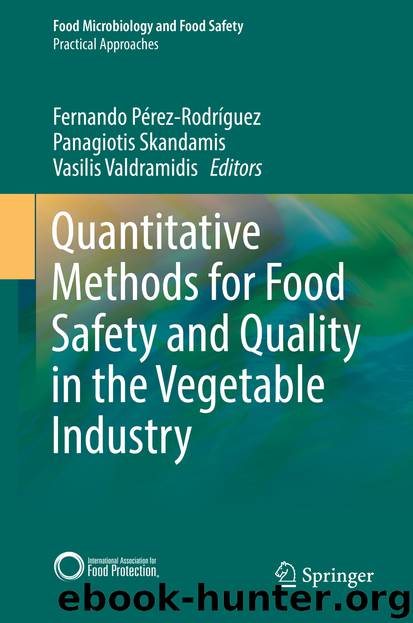Quantitative Methods for Food Safety and Quality in the Vegetable Industry by Fernando Pérez-Rodríguez Panagiotis Skandamis & Vasilis Valdramidis

Author:Fernando Pérez-Rodríguez, Panagiotis Skandamis & Vasilis Valdramidis
Language: eng
Format: epub
Publisher: Springer International Publishing, Cham
4.2.2 Carrots
Quilitzsch et al. (2005) used near-infrared spectroscopy (NIRS) and the method of partial least squares (PLS) to determine the main quality parameters of fresh carrots. The study showed that it can provide a fast and nondestructive method to predict the contents of α-carotene, β-carotene, and dry matter content in fresh carrots.
4.2.3 Pickling Cucumbers
Kavdir et al. (2007) developed a nondestructive method for measuring the firmness, skin and flesh color, and dry matter content of pickling cucumbers by means of visible and near-infrared (Vis/NIR) spectroscopy. Partial least squares method was used as calibration models for predicting firmness, skin and flesh chroma and hue, and dry matter content. The coefficient of determination (R 2) of 0.67–0.70 for firmness was obtained. Vis/NIR measurements had good correlations with skin chroma (R 2 = 0.89 and 0.83 for calibration and validation, respectively) and hue (R 2 = 0.76 for calibration and validation). Promising results were obtained in predicting dry matter content of the cucumbers with R 2 = 0.65 in validation. Result showed that visible and NIR spectroscopy is potentially useful for sorting and grading pickling cucumbers.
Mechanical injury often causes hidden internal damage to pickling cucumbers, which lowers the quality of pickled products and can incur economic losses to the processor. Ariana et al. (2006) used a near-infrared hyperspectral imaging system to capture hyperspectral images from pickling cucumbers in the spectral region of 900–1700 nm. Principal component analysis (PCA), band ratio, and band difference were applied in the image processing to segregate bruised cucumbers from normal cucumbers. Best detection accuracies from the PCA were achieved when a bandwidth of 8.8 nm and the spectral region of 950–1350 nm were selected. The detection accuracies from the PCA decreased from 95 to 75% over the period of 6 days after bruising. The best band ratio of 988 and 1085 nm had detection accuracies between 93 and 82%, whereas the best band difference of 1346 and 1425 nm had accuracies between 89 and 84%. The general classification performance analysis suggested that the band ratio and difference methods had similar performance, but they were better than the PCA.
Download
This site does not store any files on its server. We only index and link to content provided by other sites. Please contact the content providers to delete copyright contents if any and email us, we'll remove relevant links or contents immediately.
| Cell Biology | Developmental Biology |
| Entomology | Marine Biology |
| Microbiology | Molecular Biology |
| Biostatistics |
Sapiens: A Brief History of Humankind by Yuval Noah Harari(14252)
The Tidewater Tales by John Barth(12608)
Mastermind: How to Think Like Sherlock Holmes by Maria Konnikova(7227)
Do No Harm Stories of Life, Death and Brain Surgery by Henry Marsh(6891)
The Thirst by Nesbo Jo(6828)
Why We Sleep: Unlocking the Power of Sleep and Dreams by Matthew Walker(6618)
Life 3.0: Being Human in the Age of Artificial Intelligence by Tegmark Max(5474)
Sapiens by Yuval Noah Harari(5294)
The Longevity Diet by Valter Longo(5021)
The Body: A Guide for Occupants by Bill Bryson(4974)
The Rules Do Not Apply by Ariel Levy(4861)
The Immortal Life of Henrietta Lacks by Rebecca Skloot(4525)
Animal Frequency by Melissa Alvarez(4395)
Why We Sleep by Matthew Walker(4360)
The Hacking of the American Mind by Robert H. Lustig(4318)
Yoga Anatomy by Kaminoff Leslie(4306)
All Creatures Great and Small by James Herriot(4233)
Double Down (Diary of a Wimpy Kid Book 11) by Jeff Kinney(4207)
Barron's AP Biology by Goldberg M.S. Deborah T(4098)
